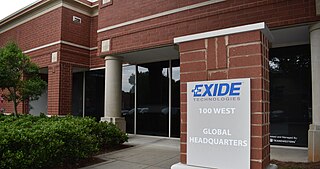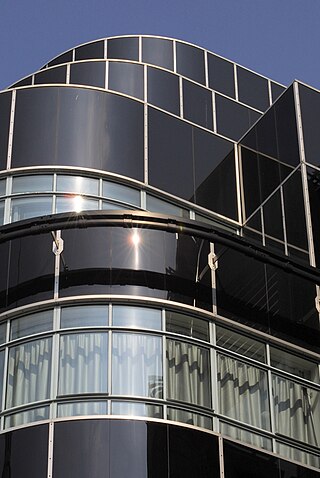Vetrazzo is a company based in Tate, Georgia, United States.
Contents
This patented process takes industrial waste in large quantities and transforms it into sturdy 9' by 5' polished slabs.
Vetrazzo is a company based in Tate, Georgia, United States.
This patented process takes industrial waste in large quantities and transforms it into sturdy 9' by 5' polished slabs.
Vetrazzo recycled glass countertops were invented in Berkeley in 1996. A materials scientist, Don McPherson, pursuing his PhD combined recycled glass and a cement binder to create a sustainable, polished countertop. The company at that time was known as Counter Productions. The production batches were small and handmade, demanding a more streamlined and repeatable process. [1]
In 2006, a former customer and designer named Olivia Teter was looking for a new project and found the company in financial straits. She, together with James Sheppard and Jeff Gustafson, partnered to raise capital, buy the product formula and assets behind the Vetrazzo countertops, and co-found what is now Vetrazzo LLC. [2]
The Vetrazzo manufacturing facility was located in Richmond, California in a recycled Ford assembly plant. The plant is on the National Register of Historic Places and hosts the Rosie the Riveter Museum. It utilizes daylight, controls air pollution with a special negative-pressure dust booth, recycles water and hosts a 1 megawatt solar system manufactured by building tenant Sunpower Corporation.
In June 2010 Polycor acquired Vetrazzo and move the plant back Georgia where it now shares a manufacturing space with the Georgia Marble company.
Vetrazzo claims on their website that their countertops consist of recycled glass and a cement binder. The glass is said to have been sourced from a curbside recycling program, windows, windshields, laboratory glass, stained glass and traffic lights. Vetrazzo's website also claims that their countertops are recyclable at the end of their useful lives.
The company states that they are proud of their sustainable work, being a member of the United States Green Building Council, a certified B corporation, a certified Bay Area Green Business and a member of the Green Chamber of Commerce.
Vetrazzo's website also claims that they are committed to providing green jobs to the low-income neighborhood surrounding their offices and plant. All employees, including factory workers, are said to be provided with health care and full benefits. All Vetrazzo slabs are manufactured in the United States.
Vetrazzo was awarded a significant grant from the California Department of Conservation in 2006 and 2008 as part of a program to expand markets for recycled beverage containers. Vetrazzo is also an Environmental Protection Agency Award Winner.

Concrete is a composite material composed of aggregate bonded together with a fluid cement that cures over time. Concrete is the second-most-used substance in the world after water, and is the most widely used building material. Its usage worldwide, ton for ton, is twice that of steel, wood, plastics, and aluminium combined.

Asphalt concrete is a composite material commonly used to surface roads, parking lots, airports, and the core of embankment dams. Asphalt mixtures have been used in pavement construction since the beginning of the twentieth century. It consists of mineral aggregate bound together with bitumen, laid in layers, and compacted.
Owens Corning is an American company that develops and produces insulation, roofing, and fiberglass composites and related materials and products. It is the world's largest manufacturer of fiberglass composites. It was formed in 1935 as a partnership between two major American glassworks, Corning Glass Works and Owens-Illinois. The company employs approximately 19,000 people around the world. Owens Corning has been a Fortune 500 company every year since the list was created in 1955. The Pink Panther acts as the company's mascot and appears in most of their advertisements.
Green chemistry, similar to sustainable chemistry or circular chemistry, is an area of chemistry and chemical engineering focused on the design of products and processes that minimize or eliminate the use and generation of hazardous substances. While environmental chemistry focuses on the effects of polluting chemicals on nature, green chemistry focuses on the environmental impact of chemistry, including lowering consumption of nonrenewable resources and technological approaches for preventing pollution.

Glass wool is an insulating material made from glass fiber arranged using a binder into a texture similar to wool. The process traps many small pockets of air between the glass, and these small air pockets result in high thermal insulation properties. Glass wool is produced in rolls or in slabs, with different thermal and mechanical properties. It may also be produced as a material that can be sprayed or applied in place, on the surface to be insulated. The modern method for producing glass wool was invented by Games Slayter while he was working at the Owens-Illinois Glass Co.. He first applied for a patent for a new process to make glass wool in 1933.

Zero waste, or waste minimization, is a set of principles focused on waste prevention that encourages redesigning resource life cycles so that all products are repurposed and/or reused. The goal of the movement is to avoid sending trash to landfills, incinerators, oceans, or any other part of the environment. Currently 9% of global plastic is recycled. In a zero waste system, all materials are reused until the optimum level of consumption is reached.

Green building refers to both a structure and the application of processes that are environmentally responsible and resource-efficient throughout a building's life-cycle: from planning to design, construction, operation, maintenance, renovation, and demolition. This requires close cooperation of the contractor, the architects, the engineers, and the client at all project stages. The Green Building practice expands and complements the classical building design concerns of economy, utility, durability, and comfort. Green building also refers to saving resources to the maximum extent, including energy saving, land saving, water saving, material saving, etc., during the whole life cycle of the building, protecting the environment and reducing pollution, providing people with healthy, comfortable and efficient use of space, and being in harmony with nature Buildings that live in harmony. Green building technology focuses on low consumption, high efficiency, economy, environmental protection, integration and optimization.’

Louisiana-Pacific Corporation (LP) is an American building materials manufacturer. The Company was founded in 1973 and is currently based in Nashville, Tennessee. LP pioneered the U.S. production of oriented strand board (OSB) panels. Today, LP is the world's largest producer of OSB, and manufactures engineered wood building products. LP products are sold to builders and homeowners through building materials distributors and dealers and retail home centers.

Certified wood and paper products come from responsibly managed forests – as defined by a particular standard. With third-party forest certification, an independent standards setting organization (SSO) develops standards for good forest management, and independent auditing companies issue certificates to forest operations that comply with those standards.

Dimension stone is natural stone or rock that has been selected and finished to specific sizes or shapes. Color, texture and pattern, and surface finish of the stone are also normal requirements. Another important selection criterion is durability: the time measure of the ability of dimension stone to endure and to maintain its essential and distinctive characteristics of strength, resistance to decay, and appearance.

Glass recycling is the processing of waste glass into usable products. Glass that is crushed or imploded and ready to be remelted is called cullet. There are two types of cullet: internal and external. Internal cullet is composed of defective products detected and rejected by a quality control process during the industrial process of glass manufacturing, transition phases of product changes and production offcuts. External cullet is waste glass that has been collected or reprocessed with the purpose of recycling. External cullet is classified as waste. The word "cullet", when used in the context of end-of-waste, will always refer to external cullet.

A countertop, also counter top, counter, benchtop, worktop or kitchen bench, bunker is a raised, firm, flat, and horizontal surface. They are built for work in kitchens or other food preparation areas, bathrooms or lavatories, and workrooms in general. The surface is frequently installed upon and supported by cabinets, positioned at an ergonomic height for the user and the particular task for which it is designed. A countertop may be constructed of various materials with different attributes of functionality, durability and aesthetics, and may have built-in appliances, or accessory items relative to the intended application.

Engineered stone is a composite material made of crushed stone bound together by an adhesive to create a solid surface. The adhesive is most commonly polymer resin, with some newer versions using cement mix. This category includes engineered quartz (SiO2), polymer concrete and engineered marble stone. The application of these products depends on the original stone used. For engineered marbles the most common application is indoor flooring and walls, while the quartz based product is used primarily for kitchen countertops as an alternative to laminate or granite. Related materials include geopolymers and cast stone. Unlike terrazzo, the material is factory made in either blocks or slabs, cut and polished by fabricators, and assembled at the worksite.

Exide was originally a brand name for batteries produced by The Electric Storage Battery Company and later became Exide Corporation doing business as Exide Technologies, an American multinational lead-acid batteries manufacturing company. It manufactures automotive batteries and industrial batteries. It is based in Milton, Georgia, United States.

Pigmented structural glass, also known generically as structural glass and as vitreous marble, and marketed under the names Carrara glass, Sani Onyx, and Vitrolite, among others, is a high-strength, colored glass. Developed in the United States in 1900, it was widely used around the world in the first half of the 20th century in Art Deco and Streamline Moderne buildings. It also found use as a material for signs, tables, and areas requiring a hygienic surface. Over time, the trademarked name "vitrolite" became a generic term for the glass.
A recycled glass countertop is composed of 100% recycled glass in a cement- or petroleum-based binder. A finished recycled glass countertop often ranges from 70 to 85 percent in recycled content.
Green building on college campuses is the purposeful construction of buildings on college campuses that decreases resource usage in both the building process and also the future use of the building. The goal is to reduce CO2 emissions, energy use, and water use, while creating an atmosphere where students can be healthy and learn.
Recycling can be carried out on various raw materials. Recycling is an important part of creating more sustainable economies, reducing the cost and environmental impact of raw materials. Not all materials are easily recycled, and processing recyclable into the correct waste stream requires considerable energy. Some particular manufactured goods are not easily separated, unless specially process therefore have unique product-based recycling processes.
Florida Tile is a U.S.-based manufacturer of porcelain and ceramic tile. It is one of the United States' largest producers of glazed and unglazed porcelain wall, floor tile and ceramic wall tile. It is also an importer and distributor of ceramic and porcelain wall and floor tile, natural stone, glass and metal tiles.
The environmental impact of concrete, its manufacture, and its applications, are complex, driven in part by direct impacts of construction and infrastructure, as well as by CO2 emissions; between 4-8% of total global CO2 emissions come from concrete. Many depend on circumstances. A major component is cement, which has its own environmental and social impacts and contributes largely to those of concrete.